Project Proposal: Better Help for Smokers to Quit in New Zealand
VerifiedAdded on 2020/05/04
|10
|2260
|143
Project
AI Summary
This project proposal outlines a healthcare initiative, "Better Help for Smokers to Quit," in New Zealand, aimed at reducing smoking rates and improving public health, particularly in the Bay of Plenty region. The proposal highlights the detrimental effects of smoking, including increased risks of chronic diseases and premature death, and references government statistics on smoking prevalence and quit attempts. It details the initiative's goals, which include providing free treatment, information, and support to smokers through healthcare institutions. The proposal emphasizes the importance of healthcare professionals advising smokers to quit and the effectiveness of such advice. It presents data comparing smoking rates in the Bay of Plenty to the national average and discusses the Tobacco Control Action Plan 2015-2018. The proposal aims to reduce healthcare costs associated with smoking-related diseases and includes strategies such as questionnaires for healthcare staff and a focus on providing motivation and solutions to smokers during healthcare visits. The initiative's progress is tracked through weekly monitoring by the Ministry of Health, and it aims to improve the lives of those affected by smoking and their families.

[Organization Name]
[Date]
PROJECT
PROPOSAL
Better Help For Smokers To Quit
Prepared for: Management team
Prepared by:
1
[Date]
PROJECT
PROPOSAL
Better Help For Smokers To Quit
Prepared for: Management team
Prepared by:
1
Paraphrase This Document
Need a fresh take? Get an instant paraphrase of this document with our AI Paraphraser
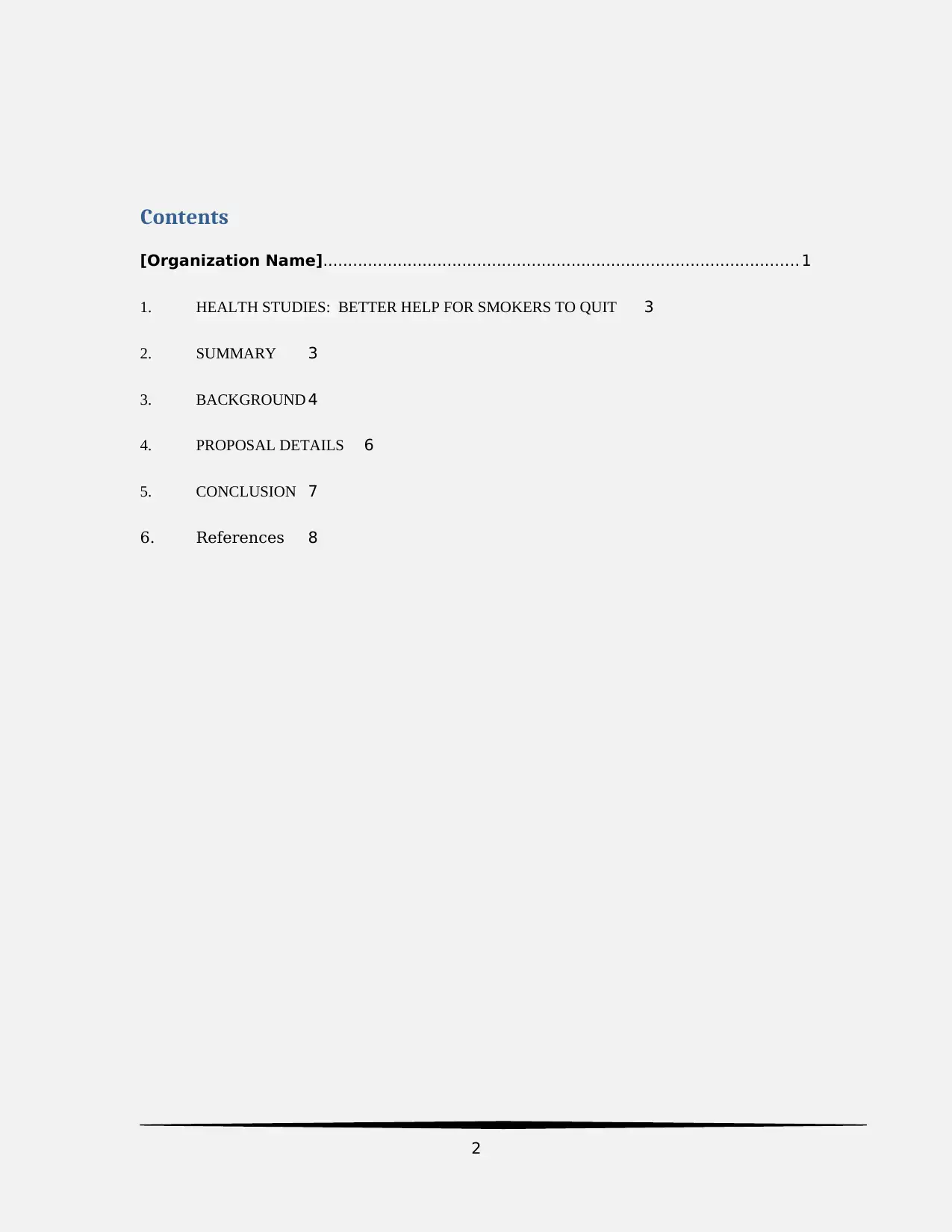
Contents
[Organization Name]................................................................................................ 1
1. HEALTH STUDIES: BETTER HELP FOR SMOKERS TO QUIT 3
2. SUMMARY 3
3. BACKGROUND 4
4. PROPOSAL DETAILS 6
5. CONCLUSION 7
6. References 8
2
[Organization Name]................................................................................................ 1
1. HEALTH STUDIES: BETTER HELP FOR SMOKERS TO QUIT 3
2. SUMMARY 3
3. BACKGROUND 4
4. PROPOSAL DETAILS 6
5. CONCLUSION 7
6. References 8
2
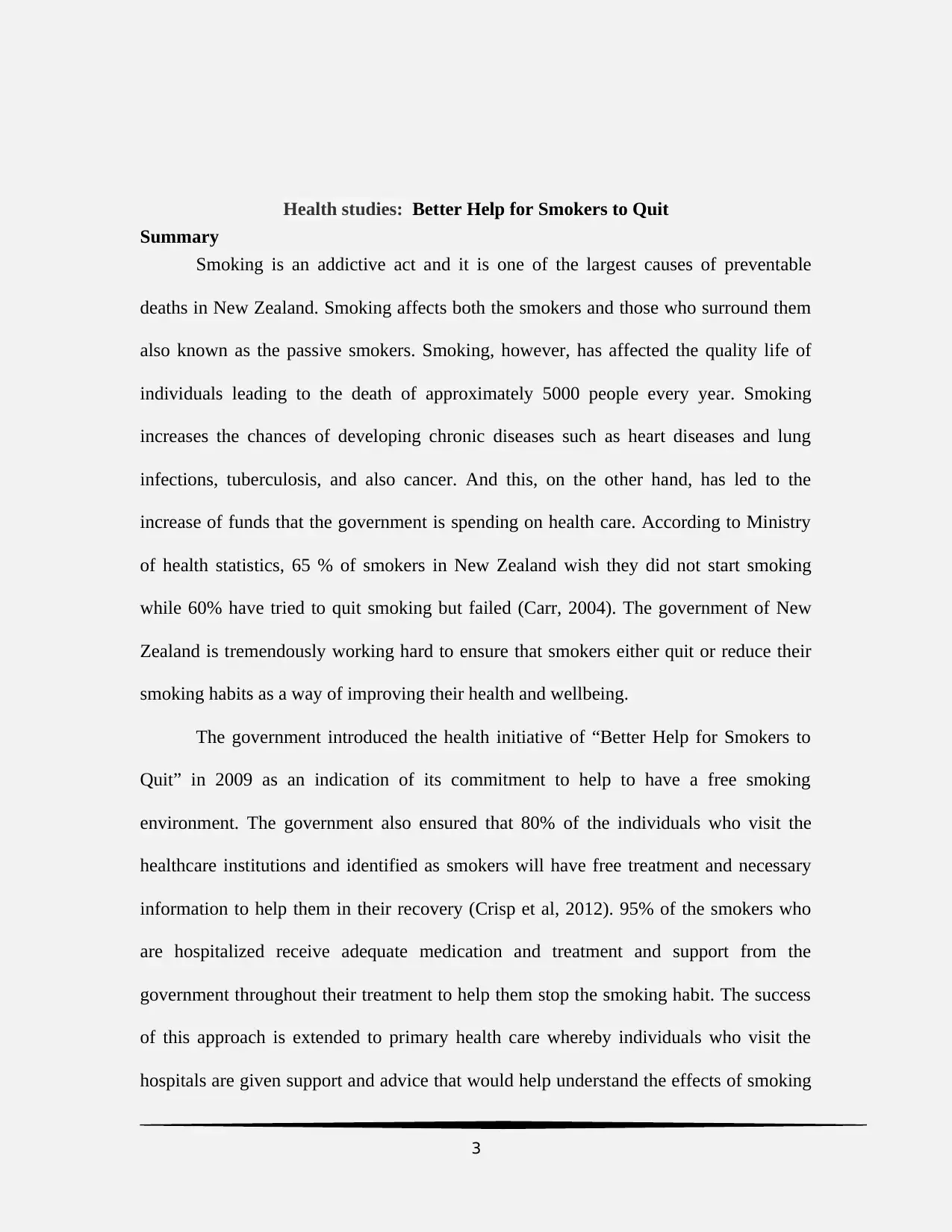
Health studies: Better Help for Smokers to Quit
Summary
Smoking is an addictive act and it is one of the largest causes of preventable
deaths in New Zealand. Smoking affects both the smokers and those who surround them
also known as the passive smokers. Smoking, however, has affected the quality life of
individuals leading to the death of approximately 5000 people every year. Smoking
increases the chances of developing chronic diseases such as heart diseases and lung
infections, tuberculosis, and also cancer. And this, on the other hand, has led to the
increase of funds that the government is spending on health care. According to Ministry
of health statistics, 65 % of smokers in New Zealand wish they did not start smoking
while 60% have tried to quit smoking but failed (Carr, 2004). The government of New
Zealand is tremendously working hard to ensure that smokers either quit or reduce their
smoking habits as a way of improving their health and wellbeing.
The government introduced the health initiative of “Better Help for Smokers to
Quit” in 2009 as an indication of its commitment to help to have a free smoking
environment. The government also ensured that 80% of the individuals who visit the
healthcare institutions and identified as smokers will have free treatment and necessary
information to help them in their recovery (Crisp et al, 2012). 95% of the smokers who
are hospitalized receive adequate medication and treatment and support from the
government throughout their treatment to help them stop the smoking habit. The success
of this approach is extended to primary health care whereby individuals who visit the
hospitals are given support and advice that would help understand the effects of smoking
3
Summary
Smoking is an addictive act and it is one of the largest causes of preventable
deaths in New Zealand. Smoking affects both the smokers and those who surround them
also known as the passive smokers. Smoking, however, has affected the quality life of
individuals leading to the death of approximately 5000 people every year. Smoking
increases the chances of developing chronic diseases such as heart diseases and lung
infections, tuberculosis, and also cancer. And this, on the other hand, has led to the
increase of funds that the government is spending on health care. According to Ministry
of health statistics, 65 % of smokers in New Zealand wish they did not start smoking
while 60% have tried to quit smoking but failed (Carr, 2004). The government of New
Zealand is tremendously working hard to ensure that smokers either quit or reduce their
smoking habits as a way of improving their health and wellbeing.
The government introduced the health initiative of “Better Help for Smokers to
Quit” in 2009 as an indication of its commitment to help to have a free smoking
environment. The government also ensured that 80% of the individuals who visit the
healthcare institutions and identified as smokers will have free treatment and necessary
information to help them in their recovery (Crisp et al, 2012). 95% of the smokers who
are hospitalized receive adequate medication and treatment and support from the
government throughout their treatment to help them stop the smoking habit. The success
of this approach is extended to primary health care whereby individuals who visit the
hospitals are given support and advice that would help understand the effects of smoking
3
⊘ This is a preview!⊘
Do you want full access?
Subscribe today to unlock all pages.

Trusted by 1+ million students worldwide
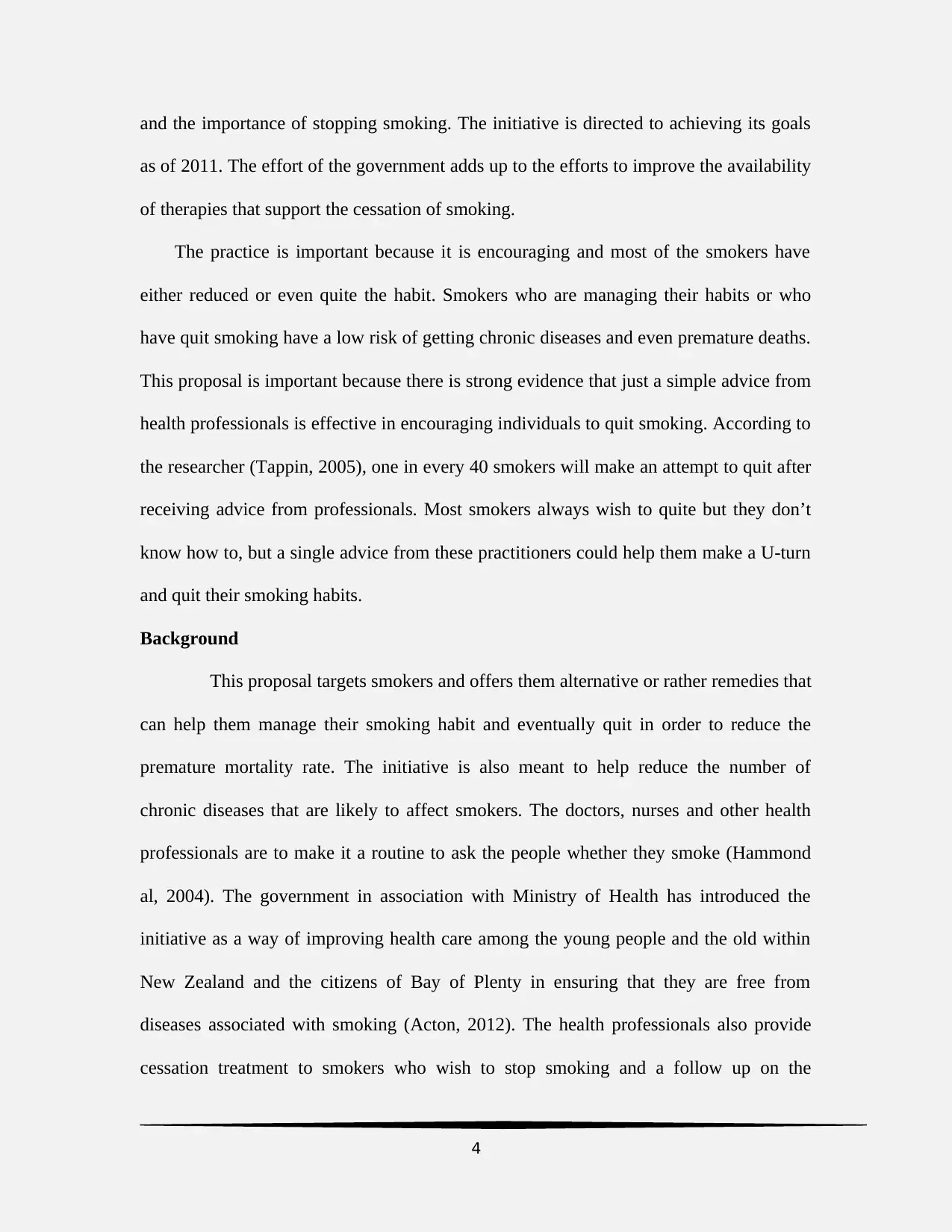
and the importance of stopping smoking. The initiative is directed to achieving its goals
as of 2011. The effort of the government adds up to the efforts to improve the availability
of therapies that support the cessation of smoking.
The practice is important because it is encouraging and most of the smokers have
either reduced or even quite the habit. Smokers who are managing their habits or who
have quit smoking have a low risk of getting chronic diseases and even premature deaths.
This proposal is important because there is strong evidence that just a simple advice from
health professionals is effective in encouraging individuals to quit smoking. According to
the researcher (Tappin, 2005), one in every 40 smokers will make an attempt to quit after
receiving advice from professionals. Most smokers always wish to quite but they don’t
know how to, but a single advice from these practitioners could help them make a U-turn
and quit their smoking habits.
Background
This proposal targets smokers and offers them alternative or rather remedies that
can help them manage their smoking habit and eventually quit in order to reduce the
premature mortality rate. The initiative is also meant to help reduce the number of
chronic diseases that are likely to affect smokers. The doctors, nurses and other health
professionals are to make it a routine to ask the people whether they smoke (Hammond
al, 2004). The government in association with Ministry of Health has introduced the
initiative as a way of improving health care among the young people and the old within
New Zealand and the citizens of Bay of Plenty in ensuring that they are free from
diseases associated with smoking (Acton, 2012). The health professionals also provide
cessation treatment to smokers who wish to stop smoking and a follow up on the
4
as of 2011. The effort of the government adds up to the efforts to improve the availability
of therapies that support the cessation of smoking.
The practice is important because it is encouraging and most of the smokers have
either reduced or even quite the habit. Smokers who are managing their habits or who
have quit smoking have a low risk of getting chronic diseases and even premature deaths.
This proposal is important because there is strong evidence that just a simple advice from
health professionals is effective in encouraging individuals to quit smoking. According to
the researcher (Tappin, 2005), one in every 40 smokers will make an attempt to quit after
receiving advice from professionals. Most smokers always wish to quite but they don’t
know how to, but a single advice from these practitioners could help them make a U-turn
and quit their smoking habits.
Background
This proposal targets smokers and offers them alternative or rather remedies that
can help them manage their smoking habit and eventually quit in order to reduce the
premature mortality rate. The initiative is also meant to help reduce the number of
chronic diseases that are likely to affect smokers. The doctors, nurses and other health
professionals are to make it a routine to ask the people whether they smoke (Hammond
al, 2004). The government in association with Ministry of Health has introduced the
initiative as a way of improving health care among the young people and the old within
New Zealand and the citizens of Bay of Plenty in ensuring that they are free from
diseases associated with smoking (Acton, 2012). The health professionals also provide
cessation treatment to smokers who wish to stop smoking and a follow up on the
4
Paraphrase This Document
Need a fresh take? Get an instant paraphrase of this document with our AI Paraphraser
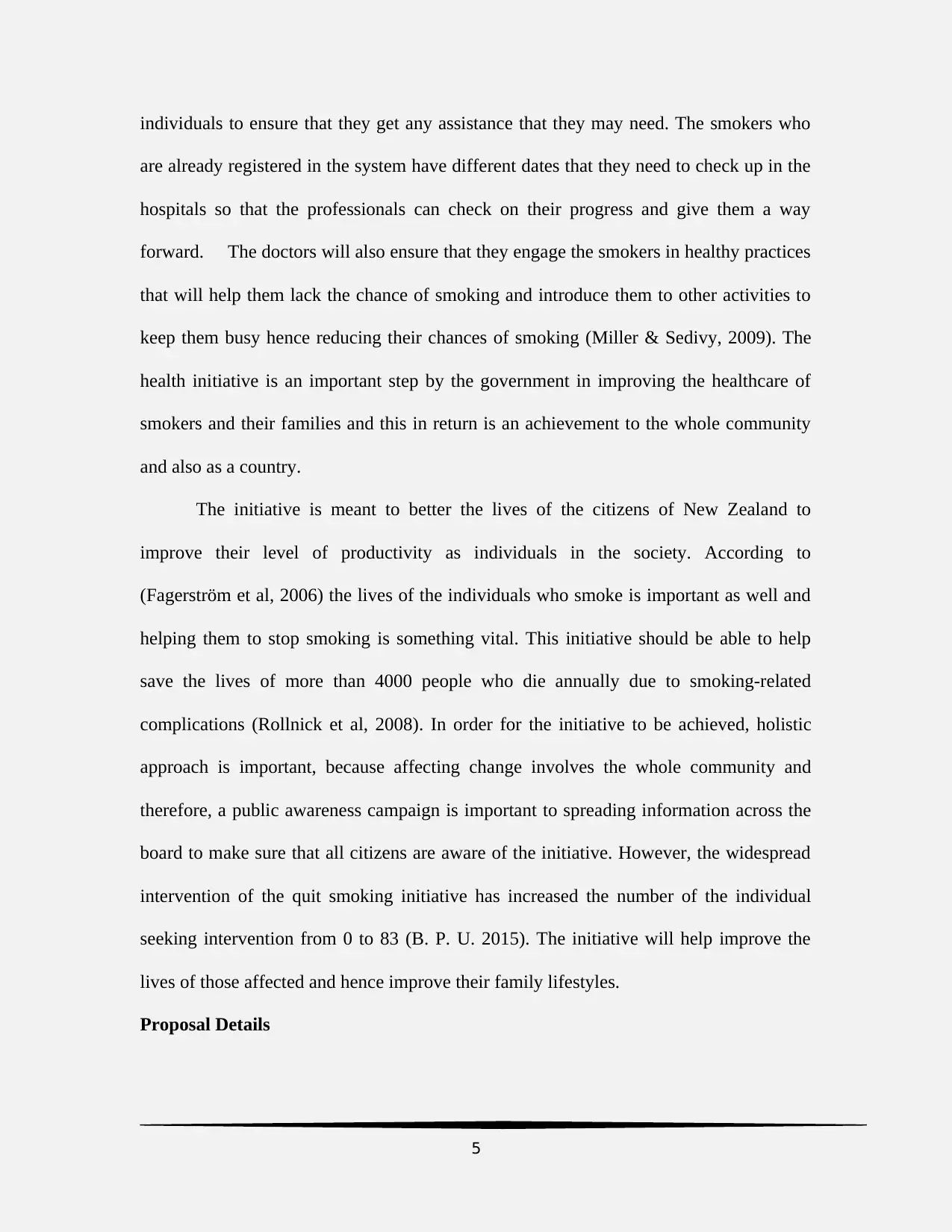
individuals to ensure that they get any assistance that they may need. The smokers who
are already registered in the system have different dates that they need to check up in the
hospitals so that the professionals can check on their progress and give them a way
forward. The doctors will also ensure that they engage the smokers in healthy practices
that will help them lack the chance of smoking and introduce them to other activities to
keep them busy hence reducing their chances of smoking (Miller & Sedivy, 2009). The
health initiative is an important step by the government in improving the healthcare of
smokers and their families and this in return is an achievement to the whole community
and also as a country.
The initiative is meant to better the lives of the citizens of New Zealand to
improve their level of productivity as individuals in the society. According to
(Fagerström et al, 2006) the lives of the individuals who smoke is important as well and
helping them to stop smoking is something vital. This initiative should be able to help
save the lives of more than 4000 people who die annually due to smoking-related
complications (Rollnick et al, 2008). In order for the initiative to be achieved, holistic
approach is important, because affecting change involves the whole community and
therefore, a public awareness campaign is important to spreading information across the
board to make sure that all citizens are aware of the initiative. However, the widespread
intervention of the quit smoking initiative has increased the number of the individual
seeking intervention from 0 to 83 (B. P. U. 2015). The initiative will help improve the
lives of those affected and hence improve their family lifestyles.
Proposal Details
5
are already registered in the system have different dates that they need to check up in the
hospitals so that the professionals can check on their progress and give them a way
forward. The doctors will also ensure that they engage the smokers in healthy practices
that will help them lack the chance of smoking and introduce them to other activities to
keep them busy hence reducing their chances of smoking (Miller & Sedivy, 2009). The
health initiative is an important step by the government in improving the healthcare of
smokers and their families and this in return is an achievement to the whole community
and also as a country.
The initiative is meant to better the lives of the citizens of New Zealand to
improve their level of productivity as individuals in the society. According to
(Fagerström et al, 2006) the lives of the individuals who smoke is important as well and
helping them to stop smoking is something vital. This initiative should be able to help
save the lives of more than 4000 people who die annually due to smoking-related
complications (Rollnick et al, 2008). In order for the initiative to be achieved, holistic
approach is important, because affecting change involves the whole community and
therefore, a public awareness campaign is important to spreading information across the
board to make sure that all citizens are aware of the initiative. However, the widespread
intervention of the quit smoking initiative has increased the number of the individual
seeking intervention from 0 to 83 (B. P. U. 2015). The initiative will help improve the
lives of those affected and hence improve their family lifestyles.
Proposal Details
5
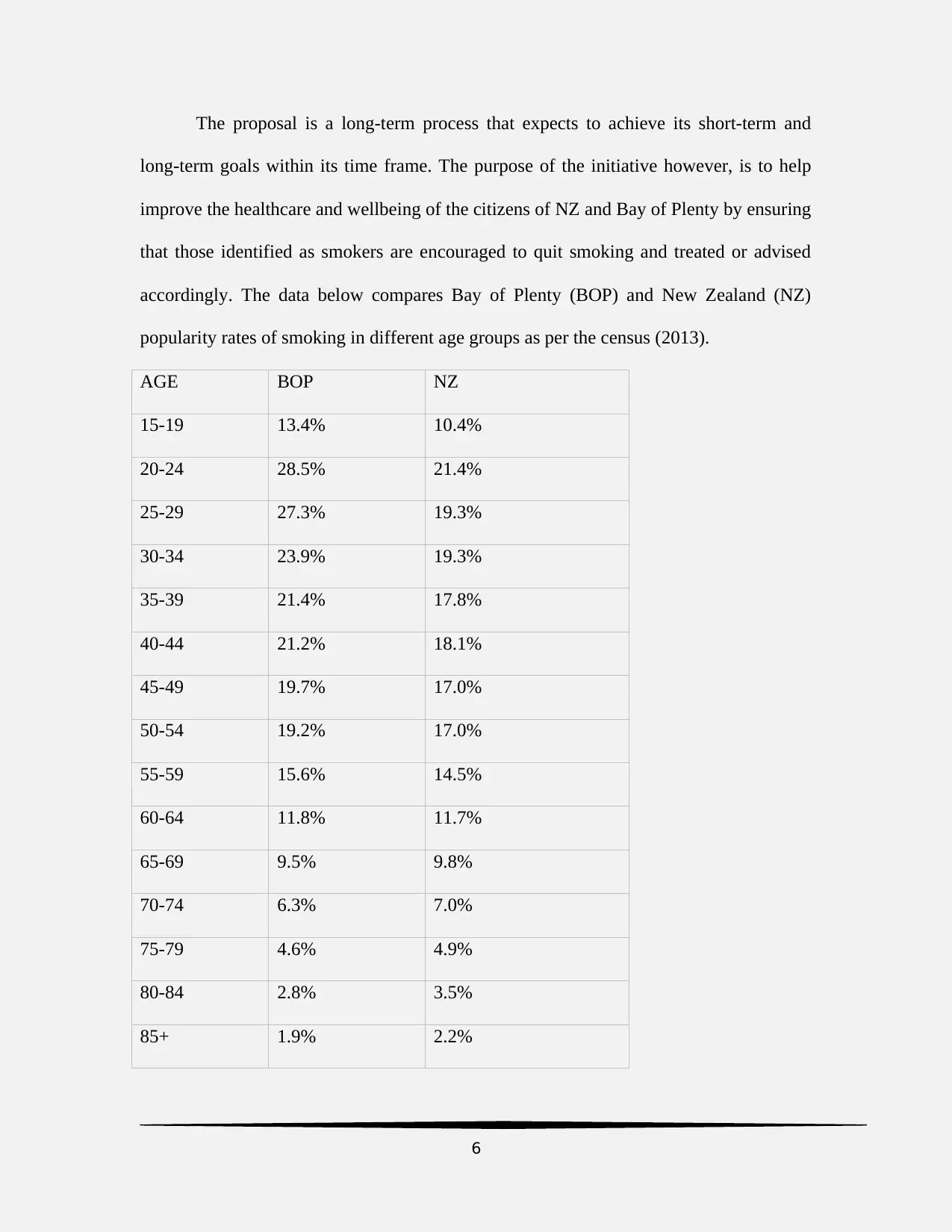
The proposal is a long-term process that expects to achieve its short-term and
long-term goals within its time frame. The purpose of the initiative however, is to help
improve the healthcare and wellbeing of the citizens of NZ and Bay of Plenty by ensuring
that those identified as smokers are encouraged to quit smoking and treated or advised
accordingly. The data below compares Bay of Plenty (BOP) and New Zealand (NZ)
popularity rates of smoking in different age groups as per the census (2013).
AGE BOP NZ
15-19 13.4% 10.4%
20-24 28.5% 21.4%
25-29 27.3% 19.3%
30-34 23.9% 19.3%
35-39 21.4% 17.8%
40-44 21.2% 18.1%
45-49 19.7% 17.0%
50-54 19.2% 17.0%
55-59 15.6% 14.5%
60-64 11.8% 11.7%
65-69 9.5% 9.8%
70-74 6.3% 7.0%
75-79 4.6% 4.9%
80-84 2.8% 3.5%
85+ 1.9% 2.2%
6
long-term goals within its time frame. The purpose of the initiative however, is to help
improve the healthcare and wellbeing of the citizens of NZ and Bay of Plenty by ensuring
that those identified as smokers are encouraged to quit smoking and treated or advised
accordingly. The data below compares Bay of Plenty (BOP) and New Zealand (NZ)
popularity rates of smoking in different age groups as per the census (2013).
AGE BOP NZ
15-19 13.4% 10.4%
20-24 28.5% 21.4%
25-29 27.3% 19.3%
30-34 23.9% 19.3%
35-39 21.4% 17.8%
40-44 21.2% 18.1%
45-49 19.7% 17.0%
50-54 19.2% 17.0%
55-59 15.6% 14.5%
60-64 11.8% 11.7%
65-69 9.5% 9.8%
70-74 6.3% 7.0%
75-79 4.6% 4.9%
80-84 2.8% 3.5%
85+ 1.9% 2.2%
6
⊘ This is a preview!⊘
Do you want full access?
Subscribe today to unlock all pages.

Trusted by 1+ million students worldwide
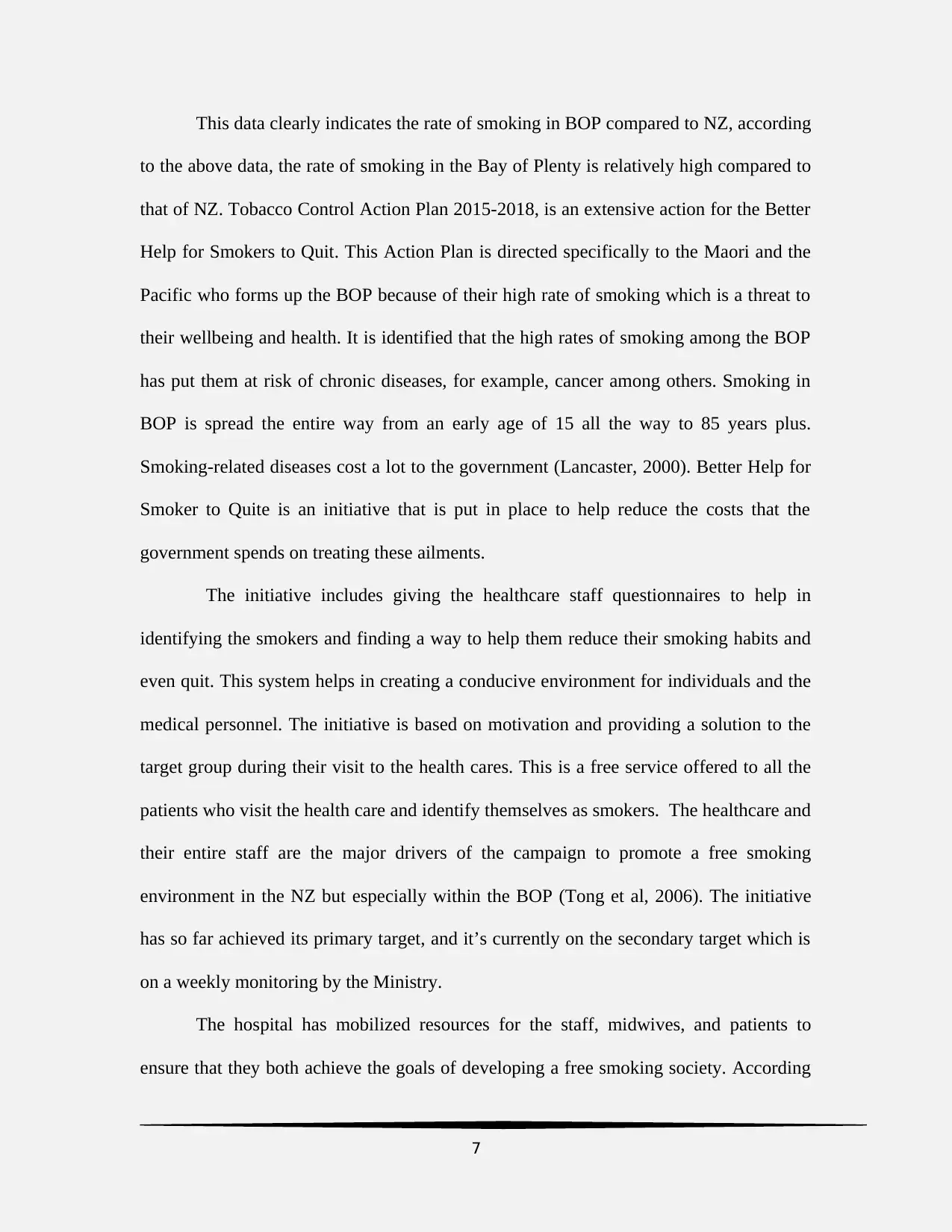
This data clearly indicates the rate of smoking in BOP compared to NZ, according
to the above data, the rate of smoking in the Bay of Plenty is relatively high compared to
that of NZ. Tobacco Control Action Plan 2015-2018, is an extensive action for the Better
Help for Smokers to Quit. This Action Plan is directed specifically to the Maori and the
Pacific who forms up the BOP because of their high rate of smoking which is a threat to
their wellbeing and health. It is identified that the high rates of smoking among the BOP
has put them at risk of chronic diseases, for example, cancer among others. Smoking in
BOP is spread the entire way from an early age of 15 all the way to 85 years plus.
Smoking-related diseases cost a lot to the government (Lancaster, 2000). Better Help for
Smoker to Quite is an initiative that is put in place to help reduce the costs that the
government spends on treating these ailments.
The initiative includes giving the healthcare staff questionnaires to help in
identifying the smokers and finding a way to help them reduce their smoking habits and
even quit. This system helps in creating a conducive environment for individuals and the
medical personnel. The initiative is based on motivation and providing a solution to the
target group during their visit to the health cares. This is a free service offered to all the
patients who visit the health care and identify themselves as smokers. The healthcare and
their entire staff are the major drivers of the campaign to promote a free smoking
environment in the NZ but especially within the BOP (Tong et al, 2006). The initiative
has so far achieved its primary target, and it’s currently on the secondary target which is
on a weekly monitoring by the Ministry.
The hospital has mobilized resources for the staff, midwives, and patients to
ensure that they both achieve the goals of developing a free smoking society. According
7
to the above data, the rate of smoking in the Bay of Plenty is relatively high compared to
that of NZ. Tobacco Control Action Plan 2015-2018, is an extensive action for the Better
Help for Smokers to Quit. This Action Plan is directed specifically to the Maori and the
Pacific who forms up the BOP because of their high rate of smoking which is a threat to
their wellbeing and health. It is identified that the high rates of smoking among the BOP
has put them at risk of chronic diseases, for example, cancer among others. Smoking in
BOP is spread the entire way from an early age of 15 all the way to 85 years plus.
Smoking-related diseases cost a lot to the government (Lancaster, 2000). Better Help for
Smoker to Quite is an initiative that is put in place to help reduce the costs that the
government spends on treating these ailments.
The initiative includes giving the healthcare staff questionnaires to help in
identifying the smokers and finding a way to help them reduce their smoking habits and
even quit. This system helps in creating a conducive environment for individuals and the
medical personnel. The initiative is based on motivation and providing a solution to the
target group during their visit to the health cares. This is a free service offered to all the
patients who visit the health care and identify themselves as smokers. The healthcare and
their entire staff are the major drivers of the campaign to promote a free smoking
environment in the NZ but especially within the BOP (Tong et al, 2006). The initiative
has so far achieved its primary target, and it’s currently on the secondary target which is
on a weekly monitoring by the Ministry.
The hospital has mobilized resources for the staff, midwives, and patients to
ensure that they both achieve the goals of developing a free smoking society. According
7
Paraphrase This Document
Need a fresh take? Get an instant paraphrase of this document with our AI Paraphraser
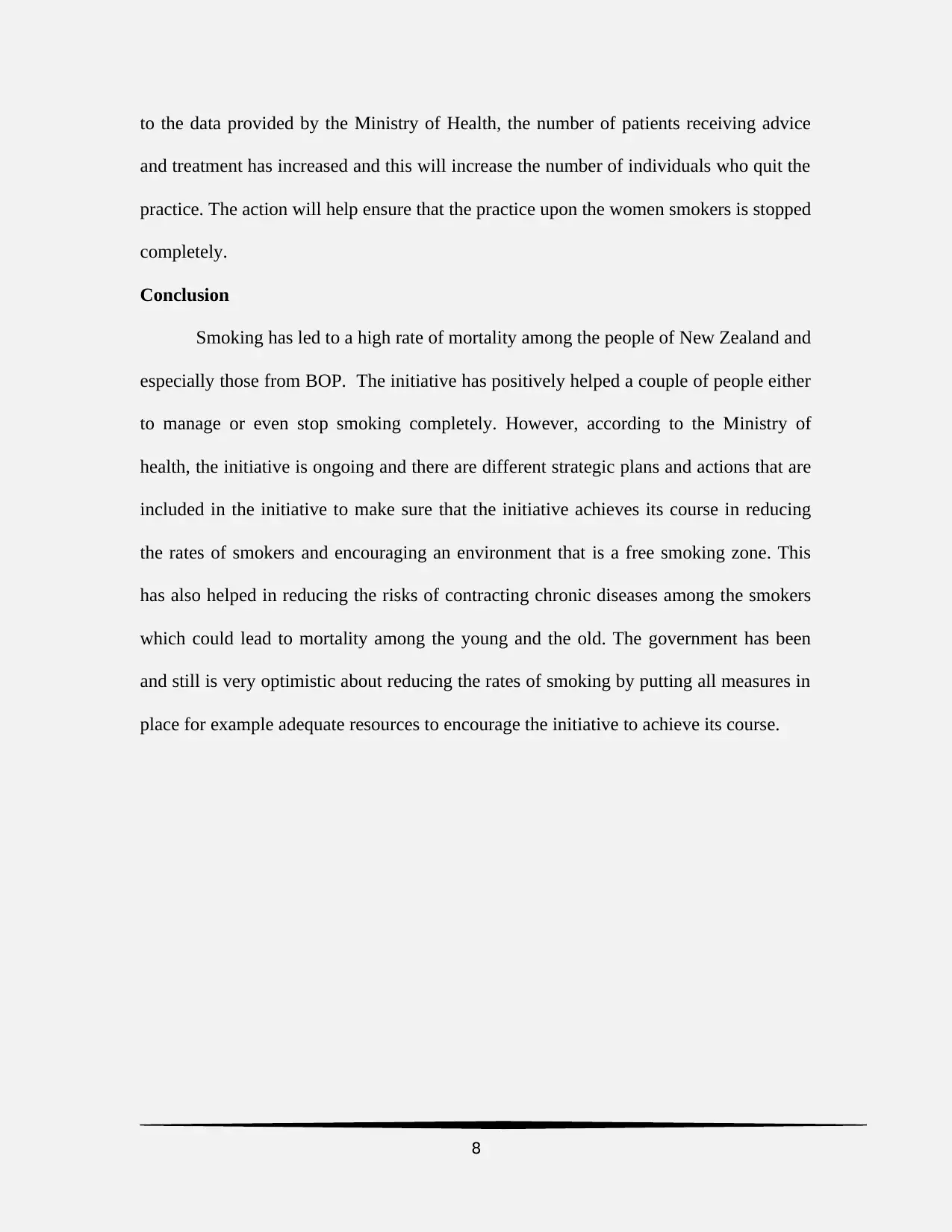
to the data provided by the Ministry of Health, the number of patients receiving advice
and treatment has increased and this will increase the number of individuals who quit the
practice. The action will help ensure that the practice upon the women smokers is stopped
completely.
Conclusion
Smoking has led to a high rate of mortality among the people of New Zealand and
especially those from BOP. The initiative has positively helped a couple of people either
to manage or even stop smoking completely. However, according to the Ministry of
health, the initiative is ongoing and there are different strategic plans and actions that are
included in the initiative to make sure that the initiative achieves its course in reducing
the rates of smokers and encouraging an environment that is a free smoking zone. This
has also helped in reducing the risks of contracting chronic diseases among the smokers
which could lead to mortality among the young and the old. The government has been
and still is very optimistic about reducing the rates of smoking by putting all measures in
place for example adequate resources to encourage the initiative to achieve its course.
8
and treatment has increased and this will increase the number of individuals who quit the
practice. The action will help ensure that the practice upon the women smokers is stopped
completely.
Conclusion
Smoking has led to a high rate of mortality among the people of New Zealand and
especially those from BOP. The initiative has positively helped a couple of people either
to manage or even stop smoking completely. However, according to the Ministry of
health, the initiative is ongoing and there are different strategic plans and actions that are
included in the initiative to make sure that the initiative achieves its course in reducing
the rates of smokers and encouraging an environment that is a free smoking zone. This
has also helped in reducing the risks of contracting chronic diseases among the smokers
which could lead to mortality among the young and the old. The government has been
and still is very optimistic about reducing the rates of smoking by putting all measures in
place for example adequate resources to encourage the initiative to achieve its course.
8
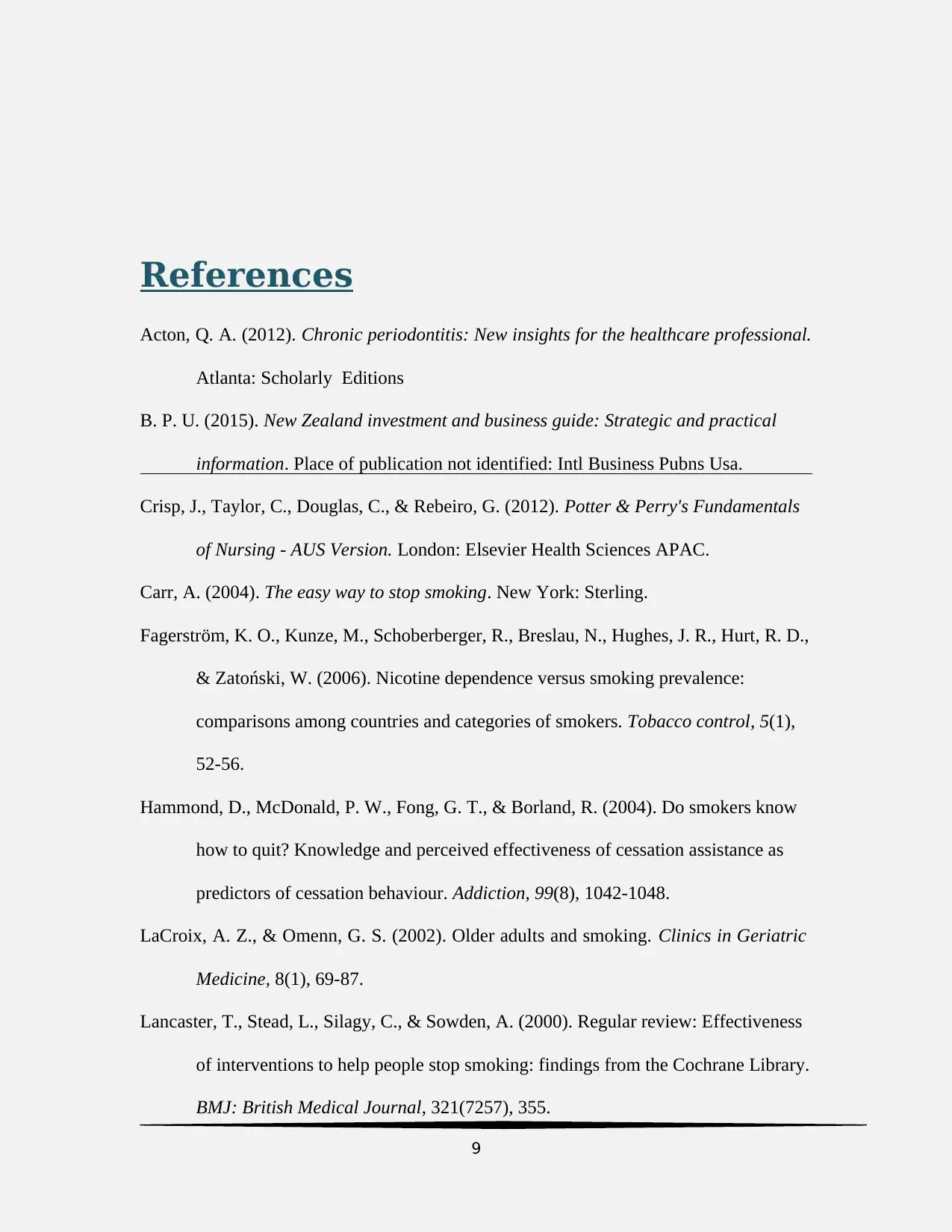
References
Acton, Q. A. (2012). Chronic periodontitis: New insights for the healthcare professional.
Atlanta: Scholarly Editions
B. P. U. (2015). New Zealand investment and business guide: Strategic and practical
information. Place of publication not identified: Intl Business Pubns Usa.
Crisp, J., Taylor, C., Douglas, C., & Rebeiro, G. (2012). Potter & Perry's Fundamentals
of Nursing - AUS Version. London: Elsevier Health Sciences APAC.
Carr, A. (2004). The easy way to stop smoking. New York: Sterling.
Fagerström, K. O., Kunze, M., Schoberberger, R., Breslau, N., Hughes, J. R., Hurt, R. D.,
& Zatoński, W. (2006). Nicotine dependence versus smoking prevalence:
comparisons among countries and categories of smokers. Tobacco control, 5(1),
52-56.
Hammond, D., McDonald, P. W., Fong, G. T., & Borland, R. (2004). Do smokers know
how to quit? Knowledge and perceived effectiveness of cessation assistance as
predictors of cessation behaviour. Addiction, 99(8), 1042-1048.
LaCroix, A. Z., & Omenn, G. S. (2002). Older adults and smoking. Clinics in Geriatric
Medicine, 8(1), 69-87.
Lancaster, T., Stead, L., Silagy, C., & Sowden, A. (2000). Regular review: Effectiveness
of interventions to help people stop smoking: findings from the Cochrane Library.
BMJ: British Medical Journal, 321(7257), 355.
9
Acton, Q. A. (2012). Chronic periodontitis: New insights for the healthcare professional.
Atlanta: Scholarly Editions
B. P. U. (2015). New Zealand investment and business guide: Strategic and practical
information. Place of publication not identified: Intl Business Pubns Usa.
Crisp, J., Taylor, C., Douglas, C., & Rebeiro, G. (2012). Potter & Perry's Fundamentals
of Nursing - AUS Version. London: Elsevier Health Sciences APAC.
Carr, A. (2004). The easy way to stop smoking. New York: Sterling.
Fagerström, K. O., Kunze, M., Schoberberger, R., Breslau, N., Hughes, J. R., Hurt, R. D.,
& Zatoński, W. (2006). Nicotine dependence versus smoking prevalence:
comparisons among countries and categories of smokers. Tobacco control, 5(1),
52-56.
Hammond, D., McDonald, P. W., Fong, G. T., & Borland, R. (2004). Do smokers know
how to quit? Knowledge and perceived effectiveness of cessation assistance as
predictors of cessation behaviour. Addiction, 99(8), 1042-1048.
LaCroix, A. Z., & Omenn, G. S. (2002). Older adults and smoking. Clinics in Geriatric
Medicine, 8(1), 69-87.
Lancaster, T., Stead, L., Silagy, C., & Sowden, A. (2000). Regular review: Effectiveness
of interventions to help people stop smoking: findings from the Cochrane Library.
BMJ: British Medical Journal, 321(7257), 355.
9
⊘ This is a preview!⊘
Do you want full access?
Subscribe today to unlock all pages.

Trusted by 1+ million students worldwide
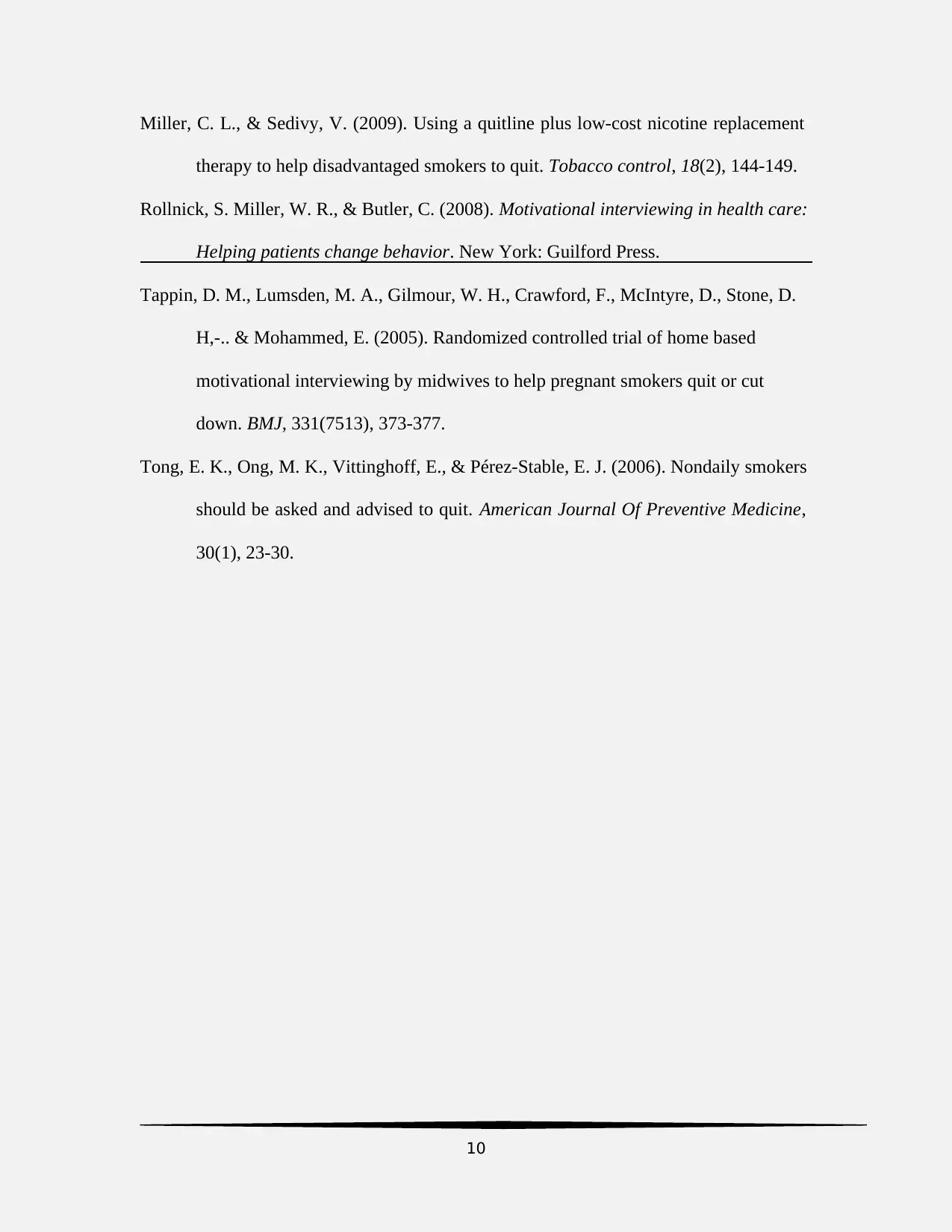
Miller, C. L., & Sedivy, V. (2009). Using a quitline plus low-cost nicotine replacement
therapy to help disadvantaged smokers to quit. Tobacco control, 18(2), 144-149.
Rollnick, S. Miller, W. R., & Butler, C. (2008). Motivational interviewing in health care:
Helping patients change behavior. New York: Guilford Press.
Tappin, D. M., Lumsden, M. A., Gilmour, W. H., Crawford, F., McIntyre, D., Stone, D.
H,-.. & Mohammed, E. (2005). Randomized controlled trial of home based
motivational interviewing by midwives to help pregnant smokers quit or cut
down. BMJ, 331(7513), 373-377.
Tong, E. K., Ong, M. K., Vittinghoff, E., & Pérez-Stable, E. J. (2006). Nondaily smokers
should be asked and advised to quit. American Journal Of Preventive Medicine,
30(1), 23-30.
10
therapy to help disadvantaged smokers to quit. Tobacco control, 18(2), 144-149.
Rollnick, S. Miller, W. R., & Butler, C. (2008). Motivational interviewing in health care:
Helping patients change behavior. New York: Guilford Press.
Tappin, D. M., Lumsden, M. A., Gilmour, W. H., Crawford, F., McIntyre, D., Stone, D.
H,-.. & Mohammed, E. (2005). Randomized controlled trial of home based
motivational interviewing by midwives to help pregnant smokers quit or cut
down. BMJ, 331(7513), 373-377.
Tong, E. K., Ong, M. K., Vittinghoff, E., & Pérez-Stable, E. J. (2006). Nondaily smokers
should be asked and advised to quit. American Journal Of Preventive Medicine,
30(1), 23-30.
10
1 out of 10
Related Documents
Your All-in-One AI-Powered Toolkit for Academic Success.
+13062052269
info@desklib.com
Available 24*7 on WhatsApp / Email
![[object Object]](/_next/static/media/star-bottom.7253800d.svg)
Unlock your academic potential
Copyright © 2020–2025 A2Z Services. All Rights Reserved. Developed and managed by ZUCOL.





